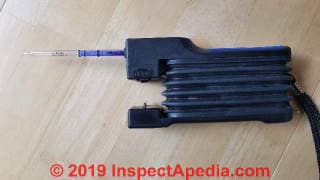 Guide to Toxic Gas Measurement Instruments & Gas Detector Tubes for Indoor Gas Level Tests
Guide to Toxic Gas Measurement Instruments & Gas Detector Tubes for Indoor Gas Level Tests
- POST a QUESTION or COMMENT about how to detect & measure hazardous gases in buildings
Types of test instruments for detecting or measuring the level of toxic or dangerous gases in buildings:
This document discusses tools and methods used to test for the level of toxic and other gases in buildings and in outdoors. In related documents we give references and explanation regarding toxicity of several of the most common indoor gases, based on literature search and obtained from the U.S. government and expert sources.
This text may assist readers in understanding these topics. However it should by no means be considered exhaustive. Seek prompt advice from your doctor or health/safety experts if you have any reason to be concerned about exposure to toxic gases.
InspectAPedia tolerates no conflicts of interest. We have no relationship with advertisers, products, or services discussed at this website.
- Daniel Friedman, Publisher/Editor/Author - See WHO ARE WE?
Tools and methods for detecting or measuring the level of gases in buildings or outdoors
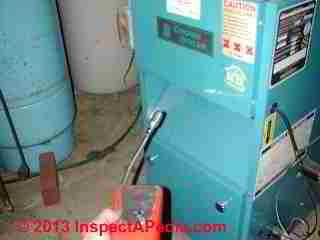 While other methods are available for gas detection in or around buildings, (such as eletronic gas detection equipment giving gas level readings in ppm and vacuum canisters for lab analysis) two common methods used by building inspectors and trades people for sensitive detection of problem gases in buildings are broad spectrum combustible gas analyzers such as
While other methods are available for gas detection in or around buildings, (such as eletronic gas detection equipment giving gas level readings in ppm and vacuum canisters for lab analysis) two common methods used by building inspectors and trades people for sensitive detection of problem gases in buildings are broad spectrum combustible gas analyzers such as
the TIF 8800 GAS DETECTOR,
and specific gas analyzers for halogens such as
the TIF 5000 GAS DETECTOR, and calibrated gas pumps using colorimetric gas detection tubes such as by Dräger discussed here.
[Click to enlarge any image]
The companies that provide pump and tube gas detection systems produce a very wide range of very sensitive calibrated gas detection tubes, all of which will work just fine with a single, volume-calibrated pump that draws the air or gas sample through the tube provided you use a gas detection tube that was properly selected for the gas and concentration range being measured and that the tube is compatible with the pump being used. .
Color changes and a scale marked on the gas detection tube give a nearly instant reading of the target gas level in the area tested.
Many other combustible gas analyzers or carbon monxide detection instruments are currently available and are given at the end of this article.
Watch out: while a gas detection instrument may itself be highly sensitive and very accurate, variations in building condtions can cause a gas to be present at times and below the limit of detection at other times.
Therefore when a gas detection test gives negative results (no gas detected) you should not rely on that result alone if there is a risk of unsafe conditions. For example
see CARBON MONOXIDE - CO poisoning.
Toxic or Hazardous Gas Detection using Calibrated Pump and Gas Detection Tubes
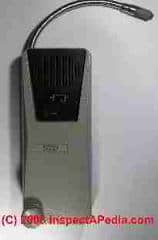 The photograph at the top of this page shows a Sensidyne gas detection hand pump which currently (2008) uses KitagawaTM gas colorimetric gas detection tubes
to measure the level of gases in a building. Here we were checking the level of carbon monoxide (CO) at a heating system.
The photograph at the top of this page shows a Sensidyne gas detection hand pump which currently (2008) uses KitagawaTM gas colorimetric gas detection tubes
to measure the level of gases in a building. Here we were checking the level of carbon monoxide (CO) at a heating system.
Above is the TIF 8800 GAS DETECTOR in use at a gas furnace draft hood, and at left is
the TIF 5000 GAS DETECTOR used for refrigerant gas detection including detection of refrigerant gas as a tracer gas if used to check for heat exchanger leaks - something no longer recommended nor permitted where discharge of refrigerants to the environment is a possibility.
We like the Sensidyne gas pump method because one or two strokes can produce an accurate quantitative measurement of the level of gas in the area with minimum manipulation of the pump by the inspector.
However indoor air quality investigators and others having need to measure concentrations of various gases in indoor or outdoor air also make very frequent use of the Draeger gas pump and Drager colorimetric gas detection tubes which we describe below, or Gastec Gas Sampling Pumps using gas detection tubes sold by GasTecTM.
Watch out: It is critical that the proper pump and gas detection tube combination be used as gas detection tubes are calibrated to work with particular gas pumps. Using the wrong pump or gas detection tube risks making inaccurate gas measurements - an error which could be fatal in some circumstances.
All of these gas detection systems use a similar approach for measuring the level of gases in a building.
The Drager system uses a rubber bellows pump which requires more pump strokes than the Sensidyne pump (shown at the top of this page) and may provide a wider range of detector tubes and gas sampling approaches.
Draeger (Dräger) provides a wide rage of gas detection tubes used with a simple hand pump - shown below.
Draeger also provides portable or wearable monitoring devices for firefighter safety such as the Dräger X-pid® 8500 that measures hazardous toxic substances such Acrolein, Benzene, Butadiene, Dichloroethylene, Ethyl benzene, Ethylene oxide, Hexane, Isobutylene, Propylene oxide, Styrene, Tetrachloroethylene, Toluene, Trichloroethylene, Vinyl chloride, Xylene,and other VOCs,
or the Dräger X-am® 8000 that for fire clearance measurement, measures up to seven gases such as CO2, O2, CO, HC, H2, H2S, NO, NO2, SO2, PH3, HCN, NH3, Amine, Odorants, Ozone,, including toxic, flammable gases and vapors, and oxygen all at once.
For use by firefighters and fire investigators, and for Civil Defense workers, Draeger also provides a special manifold for the company's gas detector hand pump.
See details at FIRE OFF-GASSING HAZARD DETECTION
Warning: About Selecting the Proper Gas Detection Tube
Gas Tube and Gas Pump Must be Compatible? Some authors report some gas detection tube interchangeability.
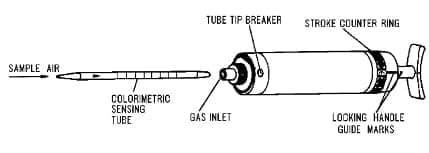 Colorimeteric gas detection tubes produced by different manufacturers are not necessarily interchangeable among gas detection pumps
Colorimeteric gas detection tubes produced by different manufacturers are not necessarily interchangeable among gas detection pumps
Be sure that the gas detection tube you are using is one recommended for use with your gas detection pump - check both the gas detection pump manufacturer's instructions and the gas detection tube manufacturer's specifications.
Watch out: we were informed in May 2008 by Nextteq GastecTM detection tube distributor in the U.S., Gastec tubes that are currently available are not intended for use on the SensidyneTM gas detection pump.
At one point in time, Sensidyne had the contract for Gastec tubes and lost it due to rebranding.
The tubes they sell now are Kitagawa tubes, not Gastec.
We don't want to confuse anyone out there that they can use a Gastec tube with the Sensidyne pump.
The Gastec tubes are not calibrated to work with a Sensidyne pump and therefore, the reading could be incorrect and prove fatal in some cases.
Really? Haag (2001) stirred a hornets' nest of marketing and technical issues, claims, counter-claims when he reported:
Both pump flow profiles and test gas measurements demonstrate that three piston hand pumps in common use (RAE Systems LP-1200, Sensidyne/Gastec GV/100, and Matheson-Kitagawa 8014-400A) are fully interchangeable.
Two bellows pumps (Draeger Accuro and MSA Kwik-Draw) also are interchangeable with each other.
Mixing of bellows and piston systems is often possible, but there are enough exceptions to conclude that such practice should be discouraged because it can lead to inaccurate readings and thus potentially dangerous overexposures.
For an example of a family of gas detection instruments & pumps capable of detecting an enormous range of specific gases and providing a measurement of gas concentration in air including pumps that use a colorimetric gas detection tube
see Dräger GAS DETECTORS.
There you will note that Hirsh (2001) vigorously objected to Haag's report, calling it marketing propaganda, and noted that Draeger as well as various agencies do not support interchangeability of gas detection tubes.
Gas Tube Must Be Properly Sensitive to the Gases Being Investigated
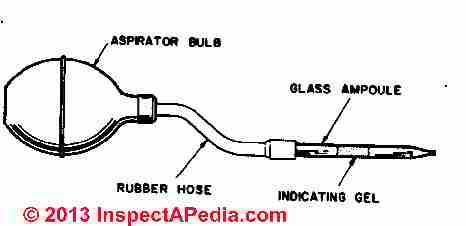 Watch out: Be sure to select gas detection tubes designed to detect the proper gases being screened in a building, and also to select the gas detector tube which is calibrated to detect gases at the proper level of concern.
Watch out: Be sure to select gas detection tubes designed to detect the proper gases being screened in a building, and also to select the gas detector tube which is calibrated to detect gases at the proper level of concern.
The detection of many gases is supported at varying levels of sensitivity.
Selecting a tube which is not sensitive enough may result in failing to detect the presence of the target gas.
Selection of a gas detection tube which is too sensitive may result in inability to accurately detect the actual level of gas which is present since the tube will become saturated before the actual gas level has been recorded.
Watch out: in our OPINION using a simple bulb-type pump with a gas detector tube (illustration above) as has been suggested in some older gas detection articles is a bad idea: if one cannot be confident that each depression of the bulb produces an accrate and known gas volume the quantitative measurement of gas concentrations given by the detector tube would be simply nonsense.
Gas Detection Instrument Sources: Carbon Monoxide, Combustion Gases, Refrigerants, Gas Detectors
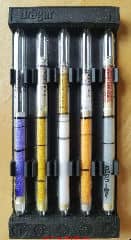 Photo: Draeger's gas detection tube set Simultantest-Set I, # 8101735, inorganic gases released during fires, detects hydrochloric acid, hydrocyanic acid, carbon monoxide, ammonia, and nitrogen dioxide.
Photo: Draeger's gas detection tube set Simultantest-Set I, # 8101735, inorganic gases released during fires, detects hydrochloric acid, hydrocyanic acid, carbon monoxide, ammonia, and nitrogen dioxide.
[Click to enlarge any image]
- Bachrach Monoxor Plus, Bachrach Fyrite Intech & other Gas Detection Instruments, Offices world wide,
Tel: USA 800-736-4666 724-334-5000
EUROPE +353 1 284 6388
CANADA 800-328-5217 905-882-8985 Website: https://www.mybacharach.com/ - Bosch Instruments
- BK Precision Gas Detectors, Website: http://www.bkprecision.com/
- BW GasAlert & other Gas Detection Instruments, GasAlert series clip on and handheld gas detection instruments, JJS Technical Services 1900 East Golf Rd., Suite 950 Schaumburg, IL 60173 Toll Free: 1-866-4 JJSTECH (1-866-455-7832) Website: https://www.bw-gasmonitors.com/
- Dräger Accuro gas detection pump, bellows-type, from Dräger Systems (also written Draeger) Draeger, Inc. 7256 S. Sam Houston W Pkwy., Suite 100 Houston, TX 77085 USA, +1-800-437-2437 Website: https://www.draeger.com
- Dräger MSDS for Dräger CH25301 Air Current Tubes, Page 1 of 2.
- Dräger MSDS for Dräger CH25301 Air Current Tubes , Page 2 of 2.
- Extech Carbon Monoxide Meters, eg. Extech CO10 CO meter, Extech FLIR, Website: http://www.extech.com/
U.S. Customer Care/Sales sales@extech.com 877-239-8324 Option 2 (9am to 5pm Eastern Time (UTC-5))
IInternational Tech Support IntlSupport@extech.com +1 603-324-7800 Option 3
Excerpt:
Checking co levels is as easy as pushing just 1 button on the model C010, which measures up to 1,000 ppm. An audible indicator increases in tone starting at 35 ppm. The higher the concentration of co, the faster the alarm will sound.
Above 200 ppm, the alarm will sound continuously. A backlight on the display can be used for low light areas. Additional features include: max hold, data hold, and auto-power-off. The meter comes complete with a 9-volt battery, protective holster, and case. - Fieldpiece Gas & Leak Detectors, Fieldpiece Instruments, Inc. 1636 WEST COLLINS AVE ORANGE, CA 92867 (714) 634-1844 FAX (714) 551-2299 getanswers@fieldpiece.com Website: http://www.fieldpiece.com/
- Fluke Gas Detection Instruments, e.g. Fluke Ti450 SF6 Gas Detector, Fluke South East Asia Pte Ltd 1 Clementi Loop, #06-02/03/04 Singapore 129808 Email: fsea.info@fluke.com Website: http://www.fluke.com/
- GasTec Corporation, Head office & production
8-8-6 Fukayanaka, Ayase-Shi, Kanagawa, 252-1195, JAPAN
Tel: +81(0)467-79-3910
See also Sensidyne or Gastec/Sensidyne GV/100 gas detectin pump.
GASTEC GAS DETECTOR TUBE HANDBOOK [PDF] (2018) retrieved 2019/02/05, original source: https://www.gastec.co.jp/files/user/asset/pdf/GAS_DETECTOR_TUBE_SYSTEM.pdf - Honeywell Analytics
405 Barclay Blvd.
Lincolnshire, IL USA 60069
Toll free: +1 888 749 8878
Fax: +1 817 274 8321
DetectGas@honeywell.com
www.honeywellanalytics.com
HONEYWELL GAS DETECTION TUBES and SAMPLING HANDBOOK, [PDF] (2014) Honeywell Analytics, op. cit., retrieved 2019/02/05 original source: https://www.honeywellanalytics.com/~/ media/honeywell-analytics/products/ colorimetric-gas-detection-tubes/documents/ hagastubeshandbook667802enlr.pdf?la=en - Industrial Scientific Gas Detection Instruments, Offices world wide, Industrial Scientific1 Life Way
Pittsburgh, Pennsylvania 15205-7500
USA Tel: 1-800-DETECTS (338-3287) Email:
info@indsci.com Website: http://www.indsci.com/ - Kitagawa 8014-400A gas detection pump
- Lascar Instruments, Email: us-sales@lascarelectronics.com Tel: 01-(814) 835 0621 Website: https://www.lascarelectronics.com
- MSA Kwik-Draw bellows-type gas detection pumps
- PCE Instruments UK Ltd., Units 12/13 Southpoint Business Park,
Ensign Way, Southampton Hampshire United Kingdom, SO31 4RF Tel: +44 023 8098 7030, Email:
info@industrial-needs.com, Website: https://www.pce-instruments.com - Promax Instruments - see RKI
- RAE Systems Inc. 1339 Moffett Park Drive Sunnyvale, CA 94089 USA Tel: 1.408.752.0723 Website: https://www.raesystems.com RAE Systems is a Honeywell subsidiary.
RAE LP-1200 DETECTION TUBE and LP-12000 OPERATION and MAINTENANCE INSTRUCTIONS [PDF] retrieved 2019/02/05 original source: https://www.raesystems.com/sites/default/files/content/resource/pump.pdf
ACCURACY COMPARISONS OF RAE SYSTEMS GAS DETECTION TUBES [PDF] (2005) RAE Systems, retrieve 2019/02/05, original source: - RKI Instruments Gas Detectors, Portable Gas Monitors, Gas Sensors, RKI Instruments, 33248 Central Ave, Union City, CA 94587 U.S.A. Tel: 1 800 754 5165 Website: http://www.rkiinstruments.com/ Email: sandra@rkiinstruments.com
Quoting from the companby's description of itsd EAGLE 2 6 Gas Sample Drawing Monitor:
The EAGLE 2 has a strong internal pump with a low flow auto pump shut off and alarm, which can draw samples from up to 125 feet. This allows for quick response and recovery from distant sampling locations. The EAGLE 2 will continuously operate for over 18 hours on alkaline batteries or 20 hours on NiMH.
A variety of accessories are also available to help satisfy almost any application such as long sample hoses, special float probes for tank testing, and dilution fittings, just to name a few. Datalogging is a standard feature for all sensors on all versions.
With its ergonomic design and large glove friendly buttons, the EAGLE 2 offers easy access to controls such as auto calibration, alarm silence, demand zero, peak hold, methane elimination, and a wide variety of other features. Each channel has two alarm levels plus TWA and STEL alarms for toxic channels.
The two alarm levels are user adjustable and can be latching or self resetting. Rugged, reliable, easy to operate and maintain, the EAGLE 2 is the solution for just about any portable gas monitoring situation. Also, the display can be set to any of 5 languages: English, French, German, Italian, or Spanish. - Robinair HVACR, Customer Service: Customer Service
Phone: 800-327-5060
Fax: 866-287-7222
Email: atpcustomerservice@service-solutions.com
Technical Support Phone: 800-327-5060 Fax: 866-287-7222 Email: atptechsupport@service-solutions.com
International Customer Service Phone: 800-327-5060 Fax: 507-455-7063 Email: intl.inquiries@service-solutions.com - Sensorcon Inspector Industrial Professional Gas Detectors, 25 Essjay Road Suite 100, Williamsville NY, 14221 USA, Tel: 1-716-566-2728 Website: https://www.sensorcon.com/
- Sensidyne Corporation, Sensidyne, LP
1000 112th Circle North, Suite 100
St. Petersburg, FL 33716
U.S.A.
800-451-9444 / +1 727-530-3602
+1 727-539-0550
info@Sensidyne.com
See also GasTec or Gastec/Sensidyne GV/100 gas detection pump.
Sensidyne's Colorimetric Gas Detector Tubes online catalog (2019/02/05) https://www.sensidyne.com/colorimetric-gas-detector-tubes/detector-tubes/
SENSIDYNE MODEL AP-20S GAS DETECTION PUMP INSTRUCTION MANUAL [PDF] (2013)Excerpt: The Model AP-20S pump is designed specifically for use with
Sensidyne/Kitagawa detector tubes.
SENSIDYNE GAS DETECTOR PUMP VOLUME VERIFICATION INSTRUCTIONS [PDF] (2003) Excerpt: To assure optimum accuracy, the volume of air drawn through a detector tube must be correct within acceptable limits. - Sensit Technologies, Gas Detectors, EG. Sensit® Gold gas leak detector, Trak-It combustible gas indicator, SENSIT Technologies 851 Transport Drive Valparaiso, IN 46383 Call Us Tel 01-219 465 2700 Toll-Free US 888 473 6748 Customer Service Email: info@gasleaksensors.com
- Testo Combustion Analyzer gas detection instruments, Testo Pty Ltd Unit 11, 114-118 Merrindale Drive Croydon South Victoria 3136 Australia 1300 837 861 Website: https://www.testo.com/
- TIF 5000 GAS DETECTOR [web article]
and TIF 8800 GAS DETECTOR. [web article] TIF, originally a Miami FL company (Thermal Industries of Florida, Inc., ) is currently a Bosch Automotive Service Solutions Brand.
- UEi CO71A & other UEi Gas Detection Instruments,
WEST: Portland, OR 8625 SW Cascade Avenue Beaverton, OR 97008 Tel: 503 644-8723 Tel: 1-800-547-5740 Fax: 503 643-6322 Email: info@ueitest.com
EAST: Indianapolis, IN 8760 E 33rd Street Indianapolis, IN 46226 Tel: 317 897-6260 Tel: 1-800-547-5740 Fax: 317 897-6261 Email: info@ueitest.com Website: http://www.ueitest.com/
Shown: UEi's Carbon Monoxide DetectorShown: UEi's Carbon Monoxide DetectorShown: UEi's Carbon Monoxide Detector
- YellowJacket Gas Detection Instruments, eg. Yellow Jacket 69373 Combustible Gas Detector (widely sold eg. at Amazon)
- Wohler Gas Detection Instruments & Flue Gas Analyzer, Wohler USA, Inc. 5 Hutchinson Drive Danvers, MA 01923 Telephone: +1 978 750 9876 Fax: +1 978 750 9799 E-mail: info@wohlerusa.com
- For a separate example of test kits & gas detection instruments focused on a specific gas
see FORMALDEHYDE GAS TEST KITS, METERS.
Reader Question: what factors affect the accuracy of gas detection instruments & methods?
I am sending this mail on behalf of [an environmental testing company in] Thessaloniki, Greece. We have recently acquired a gas detector.
I would like to ask you if you could send us any information regarding any possible factors that may affect and how, the accuracy of the measurement (indoor and outdoor) with the detector (environmental or technical).
This would help us a lot with the proper understanding and use of the detector. - A.M. Thessaloniki Greece 9/14/2012
Reply:
Watch out: AM - making a mistake in using any gas detection method, including pump selection, detector tube selection, and even more complicated, the choice of sampling time, location, and methodology can produce results that vary signfiicantly.
Making a mistake risks illness or death for building occupants if gas detection testing and test result interpretation, explanation, and reporting are not conducted accurately.
You will find additional depth and detail in articles at our website.
That said I offer these comments:
At the end of this page there is a list of articles in which we discuss the use of gas testing instruments.
Watch out: Particularly, take note of GAS DETECTOR WARNINGS
Certainly there are different classes of gas detection instrument problems and mistakes depending on variables such as
- what gas is being screened-for
- how is that gas produced - or not produced in or around a building (equipment being on-or off, for example)
- variables in building condition that completely change air and gas movement inside: windows or doors open or shut, HVAC on or off, outdoor wind level and direction, temperature, weather, even level of traffic
- site variables: nearby production of gases
- instrument calibration, use, and proper match to the problems of concern. Just holding a CO detector up near the ceiling can give different results from holding it at head, chest, or knee level - as CO produced by heating equipment is likely be mixed with warm leaky flue gases (CO doesn't leak out purely by itself).
- published exposure standards, PELS, etc for the specific gas or contaminant being studied
I found many years ago that there are problems with both false positives (detecting a "problem" level of a gas) and false negatives (missing an existing problem).
An example of false positives is using the TIF8800 - which will respond to your breath, or a flatulent bystander (no joke, I've encountered this).
After making a few conference presentations on CO detection devices we saw a surge in inspectors using them - it was horrible. What developed was the fellows stopped looking at the building, stopped thinking, and just plopped an instrument somewhere to take a reading - reporting the results and disclaiming any further responsibility.
I would start with a clear definition of the problem: what are we looking for, why, and thus where and how might a gas contaminant originate and where it might be found. I'd match the instrument, test, methodology to the problem.
I'd also check with the maufacturer and the instrument's specifications against the problem being studied.
And I have had very good experience calling both the equipment manufacturers and, in the case of specific gas tests using colorimetric gas detection tubes or other specialized instruments, I've been grateful to the technical support staff at the manufacturers: people who've been willing to help assure that the proper test is selected for the problem at hand.
Watch out: making a mistake can be dangerous or fatal for building occupants.
I think that it's for this reason that our local fire department, called to a home where there is a complaint of carbon monoxide detector alarm sounds, is reluctant to delcare a building "safe" just because their instrument detects nothing at the time of their visit. The experienced investigators know that many variables can cause the presence of a gas to wax and wane in detectability in and around a building.
Ultimately, in most cases of general field investigation for the detection of toxic or harmful gases, I would trust the results of gas detection instruments only if the instrument detects a problem; I would not fully trust a negative result.
Perhaps if you can tell me more of what you are up-to and what instrument you're talking about we could get more specific
Reader follow-up:
Thank you very much for your email. This really helps us in the proper understanding of any factors that may occur during a measurement and can change its results.
Moreover we will be properly prepared to face the problems mentioned.
Our company Envia Environmental Solutions is specialized for some years, as you can see from our website (www.envia.gr) in the deodorization of industrial areas from malodorous gases.
For this purpose and recently acquired the Eagle 2 multi gas detector from RKI to help us better identify malodorous pollutants and subsequently deal with them with the use of our products.
It can detect CO, O2, NH3, CH4, H2S and VOCs and we wanted to find out which environmental or technical factors can affect the accuracy of its measuring capability, because our company is new in this field. I will keep you informed about the instruments' performance. - A.M. Thessaloniki tech.maragoulidis@envia.gr
Reply:
Thanks for the added information; you'll see at my website that I've had a long interests in and some experience in odor source tracking and remediation.
In my experience, detecting a specific gas MIGHT, SOMETIMES point to a correctable source, particularly in industrial applications where there is more likely to be a recognizable and specific gas or chemical source.
But very often we get an odor complaint whose nature is uncertain, whose chemistry is a complex of molecules not a single specific chemical or gas (excepting methane and sewer gas problems), and whose location is mysterious to the building occupants.
Or even after a known source and event there may remain odors lingering that have been absorbed by building materials but the occupants don't know which materials are harboring the odor.
An example is the over-dose of ozone during a misguided odor remediation attempt; some building materials become oxidized - but which are the prime offenders?
Performing an in-air gas test is not going to give much help in remediation guidance in such cases.
Instead, a thoughtful review of building history along with our smell patch test approach can point to the odor source and the odor remedy.
Our home base for this topic is at ODORS GASES SMELLS, DIAGNOSIS & CURE
...
Continue reading at GAS EXPOSURE LIMITS & STANDARDS or select a topic from the closely-related articles below, or see the complete ARTICLE INDEX.
Or see To convert between % and ppm
Or see these
Recommended Articles
- COLORIMETRIC GAS DETECTION TUBES
- CONVERT PPM to % CONCENTRATION
- Drager GAS DETECTORS
- GAS DETECTION INSTRUMENTS - home
- GAS DETECTOR WARNINGS
- GAS DETECTOR TUBE WARNINGS
- GAUGE, REFRIGERATION PRESSURE TEST
- GAS EXPOSURE LIMITS & STANDARDS - home
- GASES, EXPOSURE, TESTING
- ODORS GASES SMELLS, DIAGNOSIS & CURE
- SMELL PATCH TEST to FIND ODOR SOURCE
- TIF 5000 GAS DETECTOR
- TIF 8800 GAS DETECTOR
Suggested citation for this web page
GAS DETECTION INSTRUMENTS at InspectApedia.com - online encyclopedia of building & environmental inspection, testing, diagnosis, repair, & problem prevention advice.
Or see this
INDEX to RELATED ARTICLES: ARTICLE INDEX to GAS HAZARDS in BUILDINGS
Or use the SEARCH BOX found below to Ask a Question or Search InspectApedia
Ask a Question or Search InspectApedia
Questions & answers or comments about how to detect & measure hazardous gases in buildings.
Try the search box just below, or if you prefer, post a question or comment in the Comments box below and we will respond promptly.
Search the InspectApedia website
Note: appearance of your Comment below may be delayed: if your comment contains an image, photograph, web link, or text that looks to the software as if it might be a web link, your posting will appear after it has been approved by a moderator. Apologies for the delay.
Only one image can be added per comment but you can post as many comments, and therefore images, as you like.
You will not receive a notification when a response to your question has been posted.
Please bookmark this page to make it easy for you to check back for our response.
IF above you see "Comment Form is loading comments..." then COMMENT BOX - countable.ca / bawkbox.com IS NOT WORKING.
In any case you are welcome to send an email directly to us at InspectApedia.com at editor@inspectApedia.com
We'll reply to you directly. Please help us help you by noting, in your email, the URL of the InspectApedia page where you wanted to comment.
Citations & References
In addition to any citations in the article above, a full list is available on request.
- Air Pollution Toxicology: APTI Course SI:300, Introduction to Air Pollution Toxicology, US EPA Air Pollution Training Institute, Environmental Research Center, Research Triangle Park, NC 27711, Sept. 1993, web search 08/28/2010, original source: http://yosemite.epa.gov/
- Jennifer Moore, Sales Administrator, Nextteq, LLC, Tampa FL, Nexteq 813-249-5888. Nextteq is the master Distributor for Gastec in the United States. According to the company's website, Gastec Gas Sampling Pumps are the industry’s first and only pumps to provide on-the-spot measurement of ambient temperature. [Private email, JM to DF 5/23/08]
- Michael D. Shaw, Interscan Corporation, 4590 Ish Drive #110, Simi Valley CA 93063, USA Tel: 800-458-6153, Website: www.gasdetection.com Email: info@gasdetection.com.
- "Choosing and Using a Carbon Monoxide CO Monitor," Dan Friedman, The ASHI Technical Journal, Vol. 2 No. 1, July 1991
- In addition to citations & references found in this article, see the research citations given at the end of the related articles found at our suggested
CONTINUE READING or RECOMMENDED ARTICLES.
- Carson, Dunlop & Associates Ltd., 120 Carlton Street Suite 407, Toronto ON M5A 4K2. Tel: (416) 964-9415 1-800-268-7070 Email: info@carsondunlop.com. Alan Carson is a past president of ASHI, the American Society of Home Inspectors.
Thanks to Alan Carson and Bob Dunlop, for permission for InspectAPedia to use text excerpts from The HOME REFERENCE BOOK - the Encyclopedia of Homes and to use illustrations from The ILLUSTRATED HOME .
Carson Dunlop Associates provides extensive home inspection education and report writing material. In gratitude we provide links to tsome Carson Dunlop Associates products and services.


